
“No, he didn’t slam you, he didn’t bump you, he didn’t nudge you… he rubbed you. And rubbin’, son, is racin’.” Probably my favorite quote from the movie Days of Thunder, which isn’t just one of my favorite movies about NASCAR, it’s the only one I’ve ever seen. Coincidentally, it’s also where 90% of my knowledge about stock car racing came from prior to March 24.
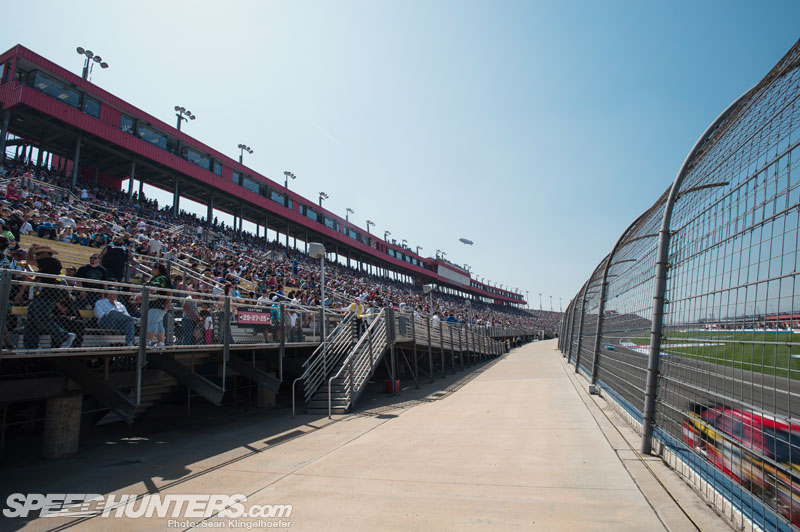
As stupid as it sounds, ever since I first saw the film at the ripe young age of five, I knew I liked NASCAR. In fact the movie, despite how inaccurate and overdone it may be, had such a profound affect on me that the only present I asked Santa for that year was “an authentic Cole Trickle racing helmet.” I’m dead serious, you can’t make that kinda thing up.
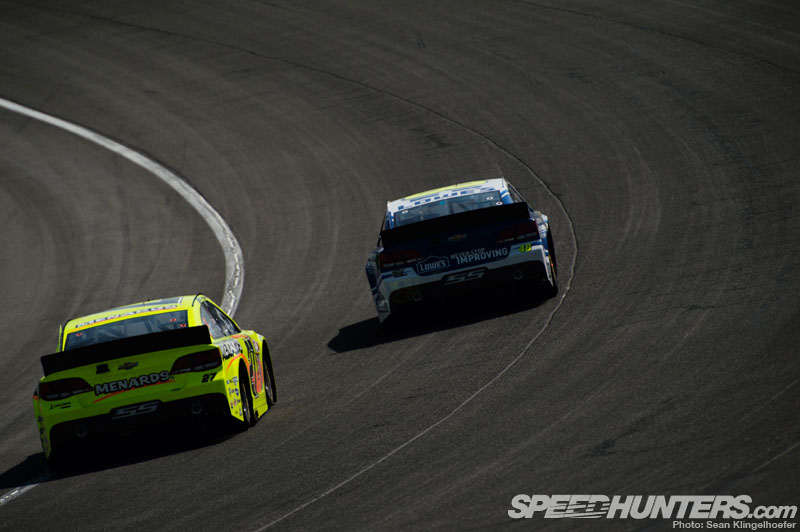
So how is it then that it took me another twenty-three years before I finally witnessed my very first Sprint Cup race? Well to be perfectly honest, I’m not entirely sure, but it wasn’t for lack of trying. I’ve attempted to get credentials for NASCAR in the past and failed, bought tickets to see a race but had to work and so on and so forth.
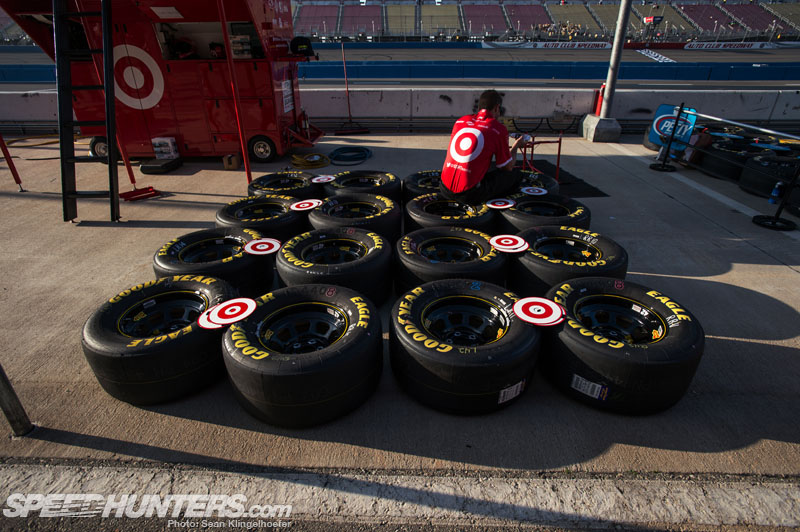
Life also has a funny way of working itself into fast forward, hence the expression “time flies.” As we get older our priorities may change, but that little kid is still buried deep down inside every one of us. All it takes is the right set of circumstances and stimuli to bring the little one back out, as I discovered one beautiful Sunday in Southern California.
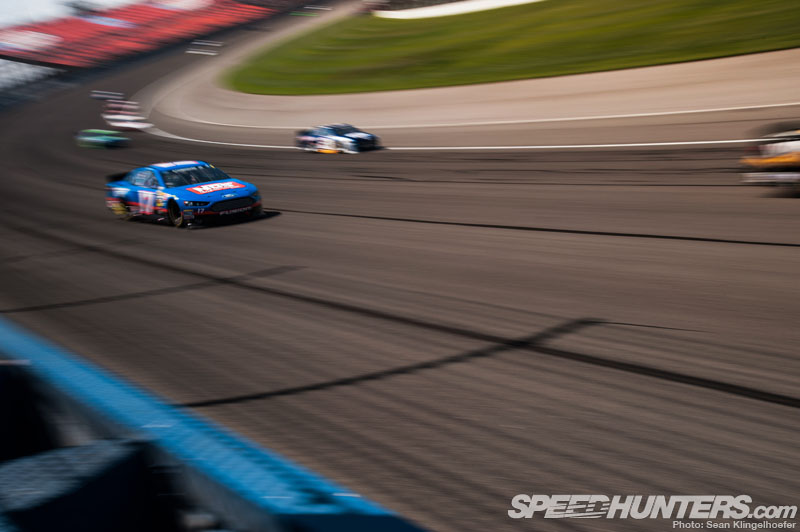
When the years roll by, our interests evolve and change. For a long time I had become a pretty die-hard road racing fan. Like many petrol heads, for a brief stint I had all but written off NASCAR as “go fast, turn left – that’s boring.” But things seem to go in cycles and eventually my interest in stock car racing picked up again and the very first thing I asked Rod about last year when I was coming on board at Speedhunters was NASCAR.
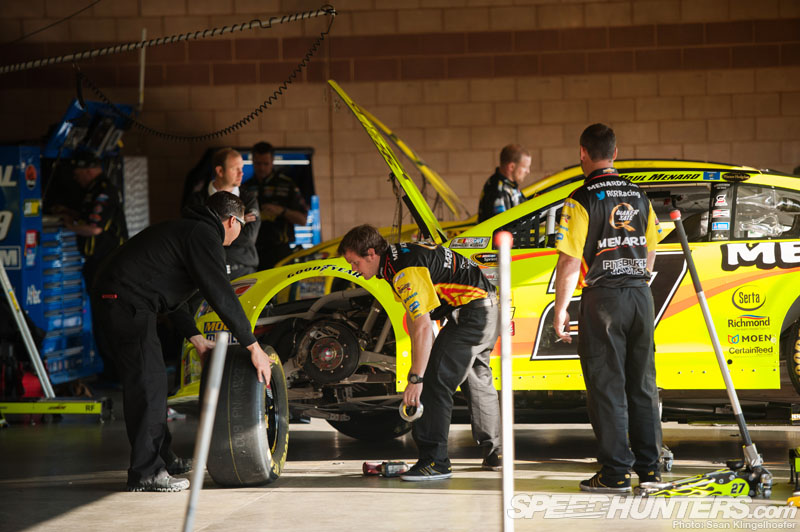
We made a few attempts to get me out to several events in 2012 and even tried to line up a car feature, all of which went south (no pun intended.) So finally, after twenty-three years of waiting, I found myself inside a NASCAR paddock for the Auto Club 400 in Fontana California. It was in all honesty one of the best days of my life. So without further ado, here’s a look at NASCAR from the fresh perspective of the five year old still living inside me.
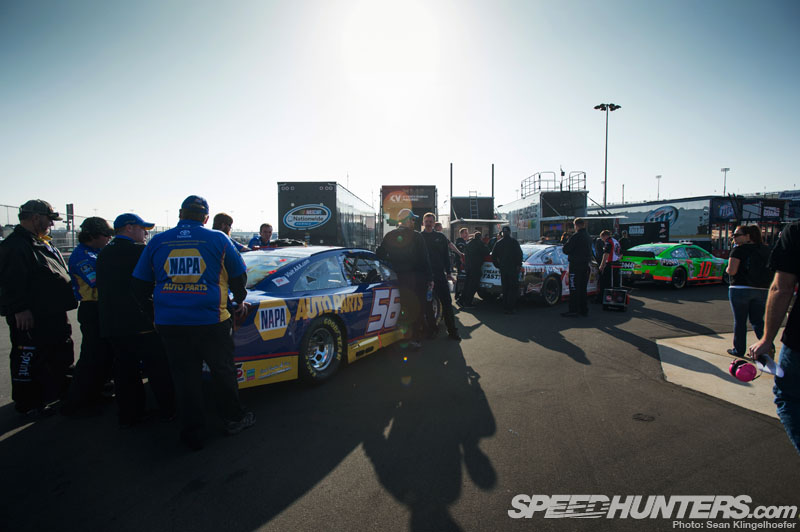
When I arrived at the track there were already tens-of-thousands of spectators on site, which made picking up my credentials and locating the media center a bit of a chore. By the time I had gotten my photo vest and all my gear set up the teams were already making their way over to scrutineering. I’ll have to ask some of you NASCAR gurus to help me out in the comments section to clarify anything I’m unsure of or just get plain wrong!
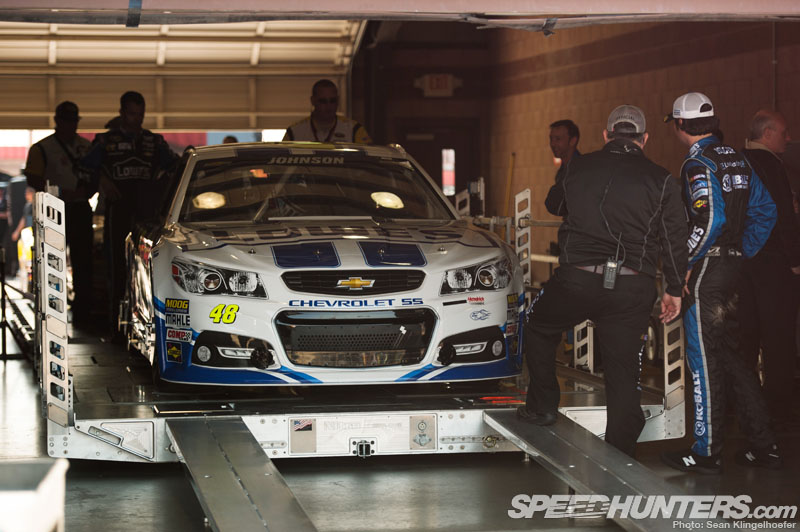
Since I didn’t have anyone from a team helping me out you have to bear in mind that everything I know is basically an educated guess combining Days of Thunder with what I could see with my own eyes. Anyway, there were several different stations in scrutineering, starting with this one where the car had some plates fixed to the wheels and then a number of measurements were taken. From what I could gather, this was weight, alignment and ride height check.
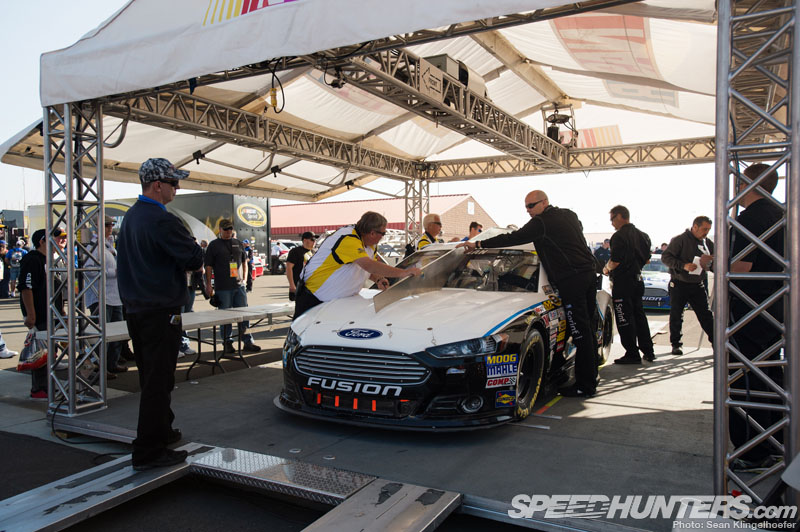
At the next station the officials begin to more closely examine the bodywork by taking out templates and tracing the roofline. They also check several other key points along the roof as well as the rear spoiler before the car moves on to the third station…
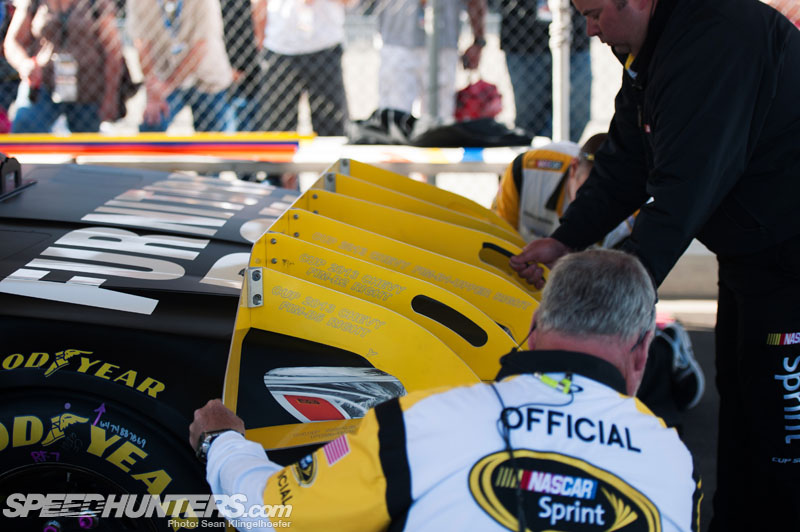
Where the most critical aero piece is analyzed – the front end. The officials would measure the splitter, end plates and hood separately before wheeling over a giant template and checking over a dozen cross sections of the front bumper. For some reason I found this part vastly interesting, I could literally have sat and watched this for days!
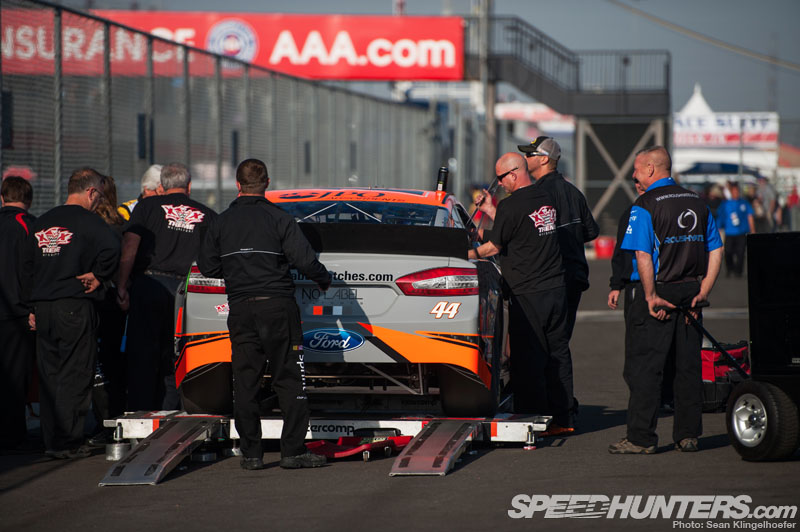
The last station was very quick and brief so I’m not sure what they were inspecting, but I think it could have been safety gear like the seat, harnesses, rollcage and helmet. Since I’ve never seen any of this on TV I was pretty stoked on this bit. I think I was the only person with a photo vest shooting scrutineering, the officials probably thought I was an insane person for taking interest in this.
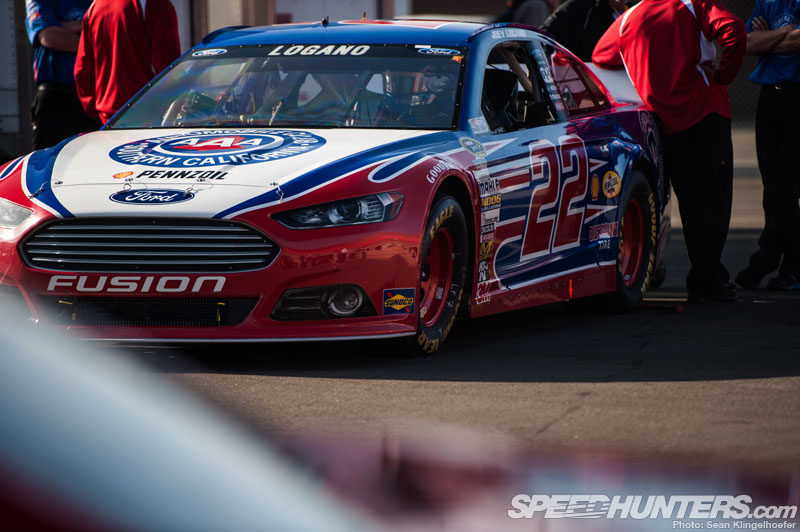
Setting up a car to only turn left and do it well requires some special alignment settings. Although I knew full well that the cars run positive camber on the inside wheels, it just looks so bizarre. Get a good look at that stance boys – positive camber, massive fender gap and pillow sidewalls – this must be like the trifecta of wrong! But it’s oh-so-right.
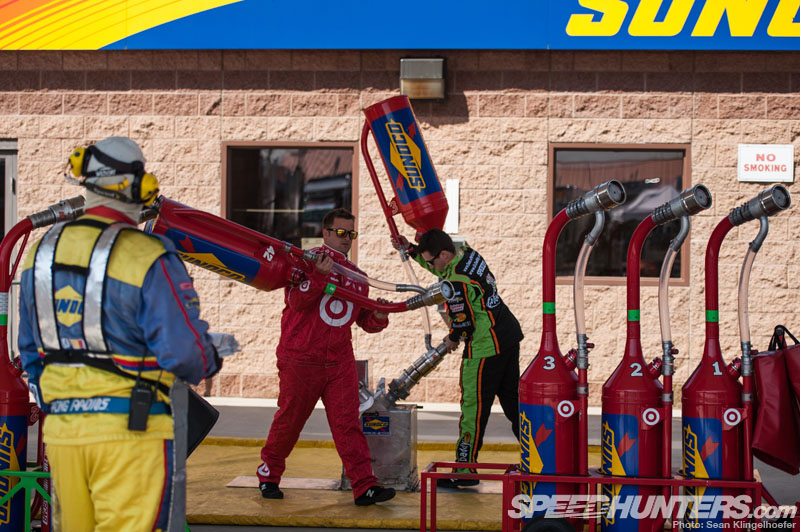
Meanwhile, as the cars are being checked before the race, so are the fuel rigs. Here it appears that the rigs are being pressurized to check for leaks, since these are controlled and gravity fed they need to be sealed to work properly.
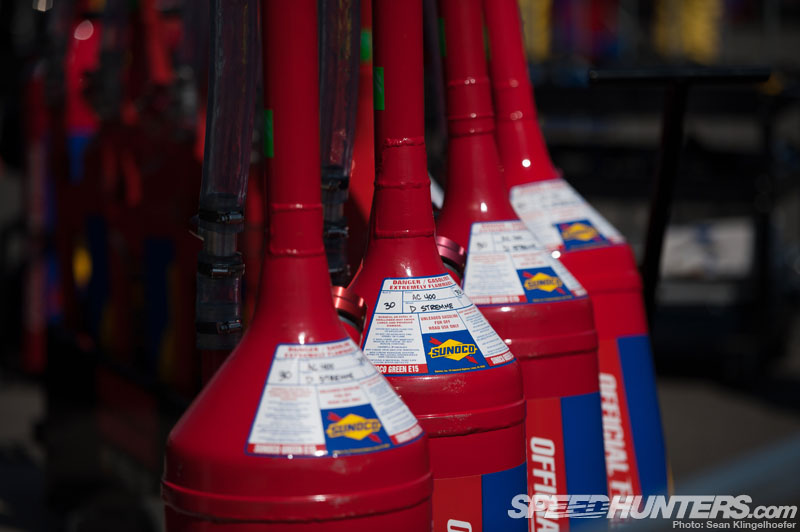
Once the rigs have passed inspection, each one gets a label indicating it’s been given the thumbs up for the weekend.
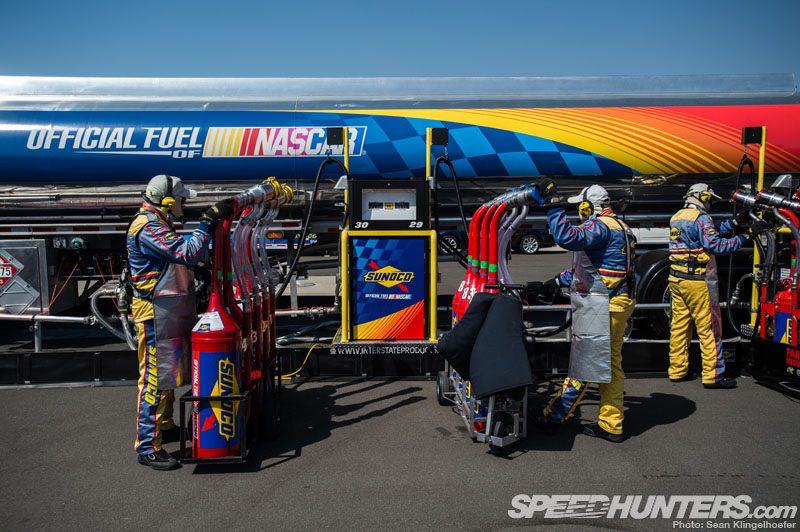
From there, the tanks are taken over to the Sunoco guys who will fill them with the regulatory amount of fuel. After they’ve been filled the rigs are carted into pit lane where they will sit until needed during a pit stop.
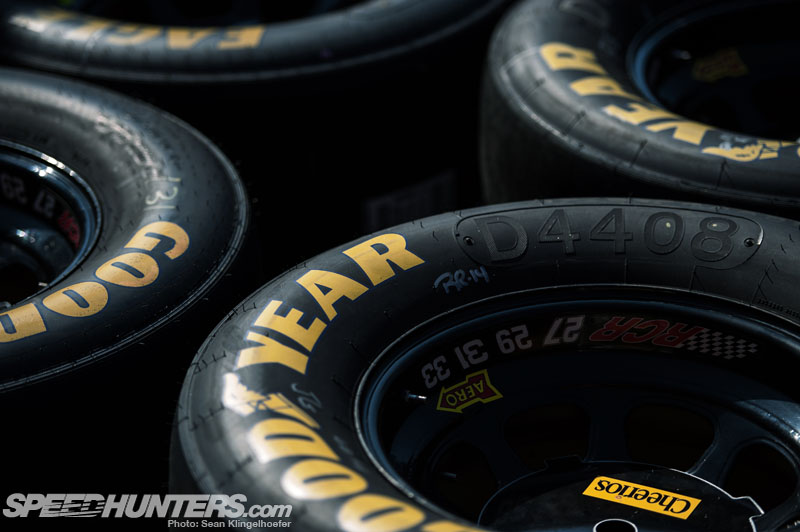
Of course fuel isn’t the only thing that is regulated by the rule book. People are often surprised to hear that NASCARs run on minuscule (by today’s standards) 15″ wheels, but what they also don’t realize is that they have to run a brake package small enough to fit inside these tiny rollers! Can you imagine stopping a car from over 200mph with a brake kit the size of a Civic’s?
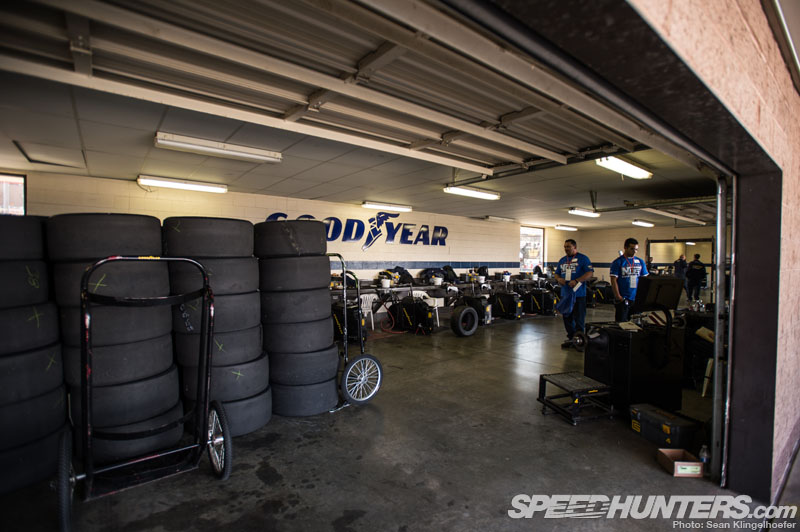
Goodyear is the sole tire supplier for the series but I am unsure of how many different compounds exist and what the rules are for any given weekend. What I do know is that these guys have to bust a crap-load of tires over the course of the weekend, but come race day things seemed to have calmed down a bit.
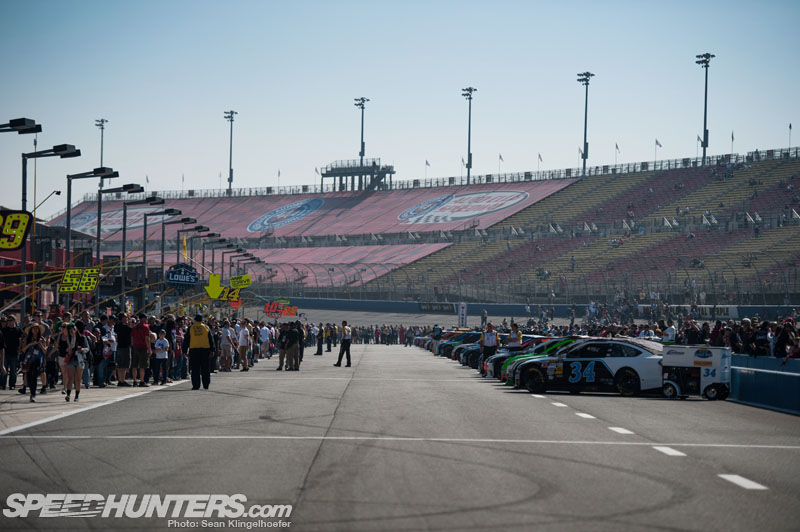
After I spent a decent amount of time in the paddock I decided to make my way to pit lane for grid walk. Unlike other forms of motorsport I’ve shot, NASCAR doesn’t let the fans get right up next to the cars and instead requires them to be behind the wall or along pit row the entire time. This is a photographer’s dream…
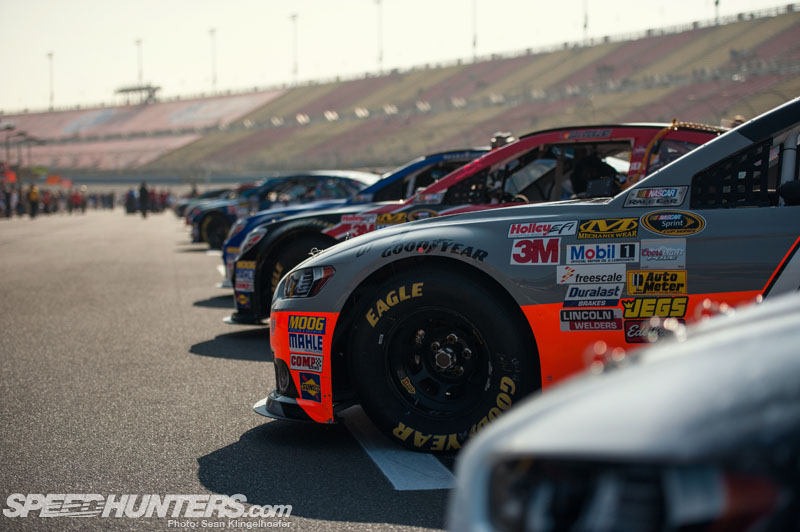
Because a shot like this simply wouldn’t be possible with thousands of people standing around. It was actually quite nice having all the space because it allowed me to walk around the cars at my own pace and really examine them up close for the first time.
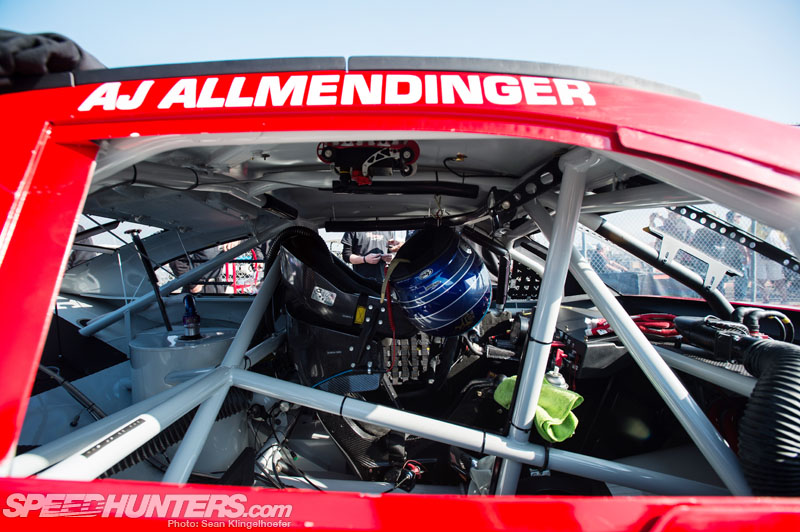
The cockpits are extraordinary! They’re so simple, yet so refined and perfected over the last sixty years, just like the rest of the car.
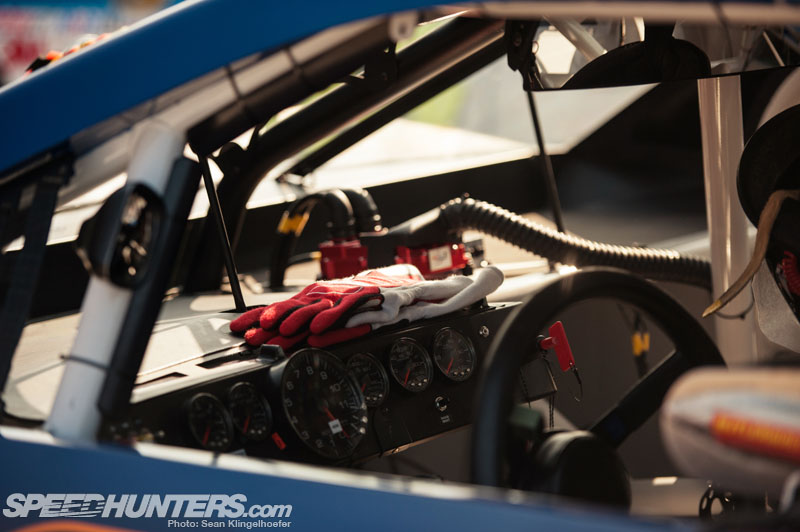
Only the absolute necessities are kept inside, even the few dials that are there almost seem irrelevant. There’s something undeniably beautiful about the simplicity of a raw machine where a driver with huge balls is the most important component.
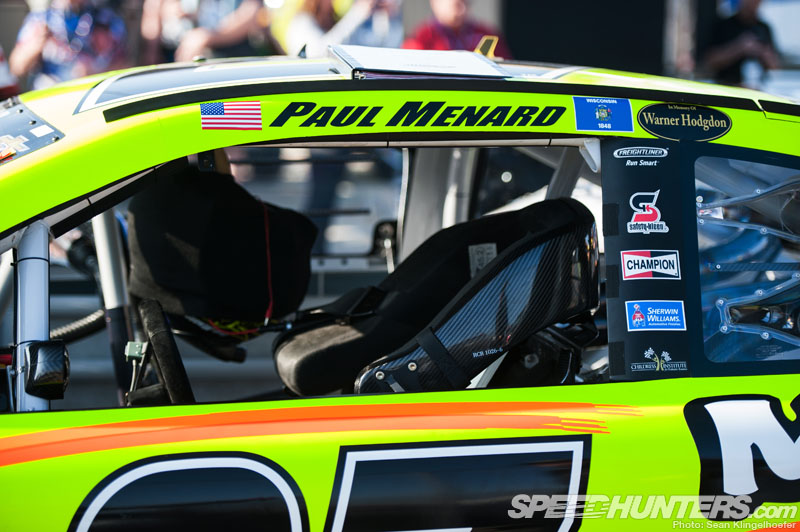
A lot has been done in recent years to advance safety in stock car racing and the current crop of seats are a testament to this fact. They’re also carbon fiber works of art! Note the additional padding on the right headrest where the driver can place his head during a high-g corner. Awesome.
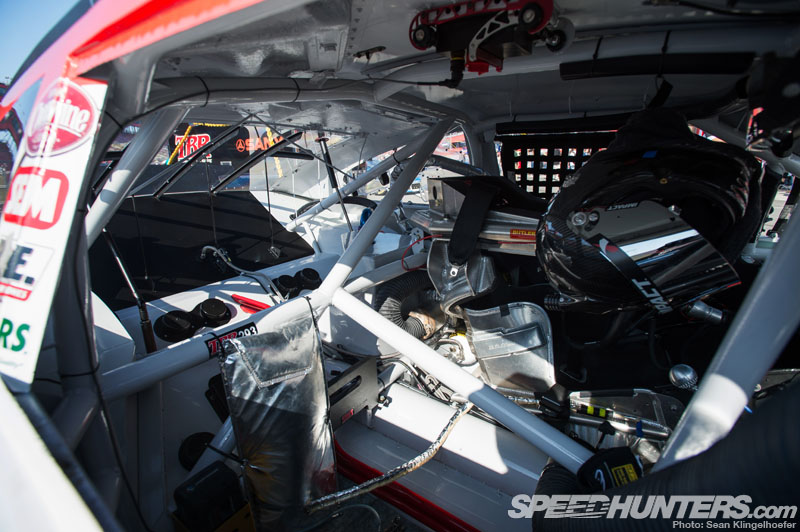
The back half of the cabin is just as lack luster. Aside from a drinks system and a few cooling ducts there isn’t much else but lots of cage and very few electronics.
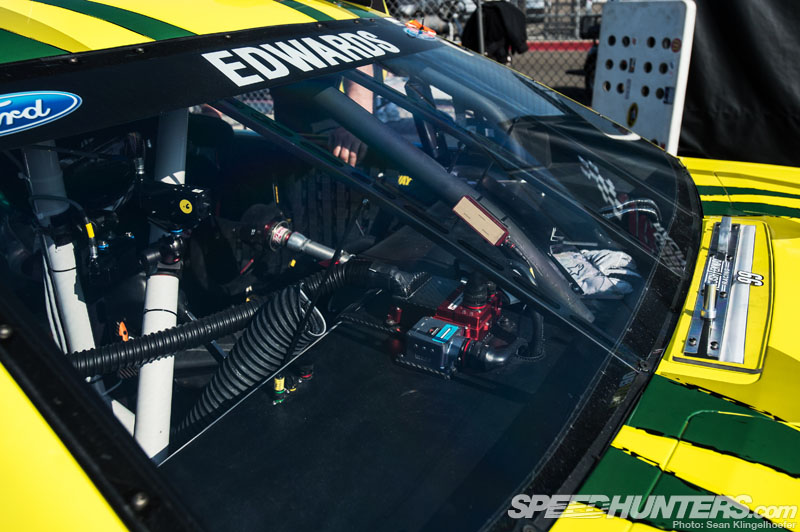
Last year was a pretty dramatic season for NASCAR as it ushered in the fuel-injection era. The little red box seen here on the dash is the car’s engine computer, and if you look at the grey box beside it you might see a logo you recognize…
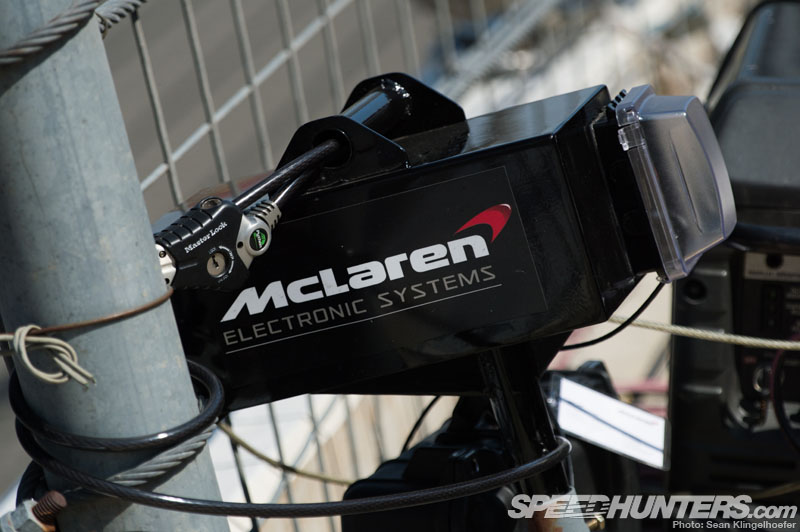
That’s right, McLaren has stepped in as the official partner and manufacturer of all engine electronics for the series. I don’t know a ton about how everything works, but from what I understand McLaren is responsible for recording car speeds and adjusting the fuel maps accordingly – sort of a digital solution to the old restrictor plate problem. Level playing field indeed.
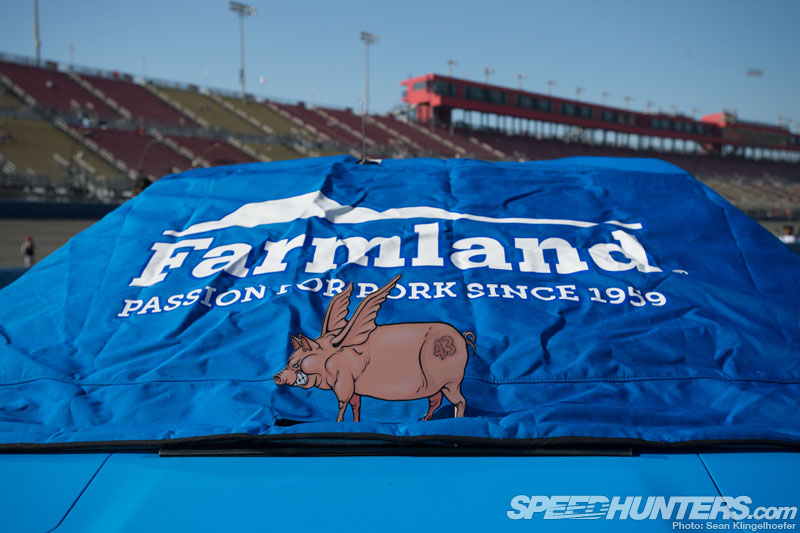
I have no idea why these exist, but virtually every car had a small plate blocking the opening for the intake with some kind of branding or signage on it. This was one of the more fascinating ones, although there were many that were far more elaborate.
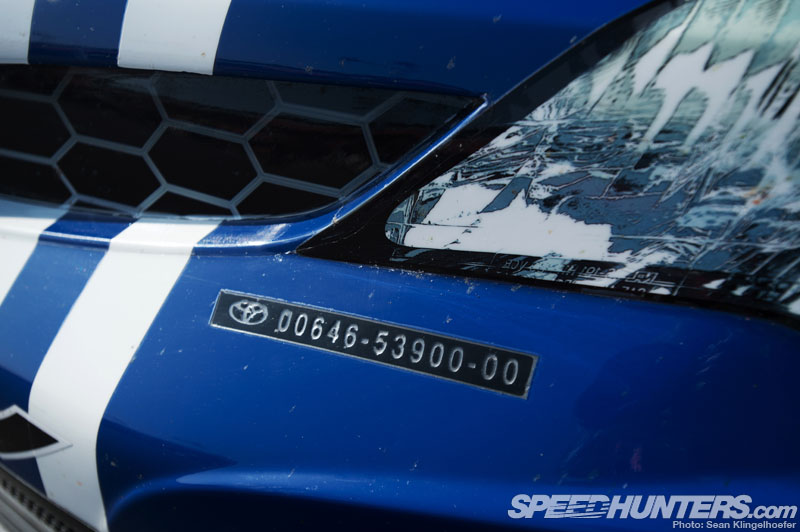
I also noticed that nearly every component had a trackable part number. For a racing series that is regarded as “low tech” they sure do an excellent job of cataloging every last detail. I think that the basic shape of the cars and the race format fools a lot of people into thinking that these are old-fashioned racers, which I can assure you they are not.
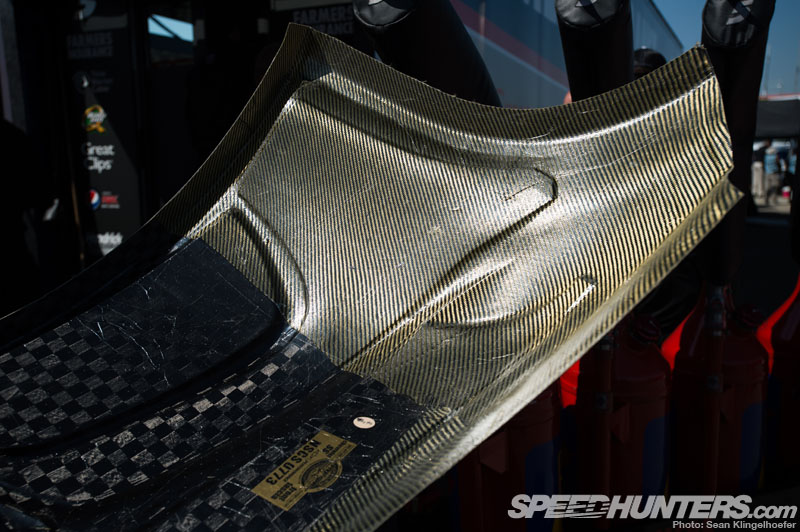
While it might not look it on the outside, underneath the surface these cars are every bit as advanced as an open wheeler or a sports car prototype. These cars are cutting edge machines built to occupy every last inch of rulebook freedom they can, it’s simply that the rule makers are very good at holding the reins.
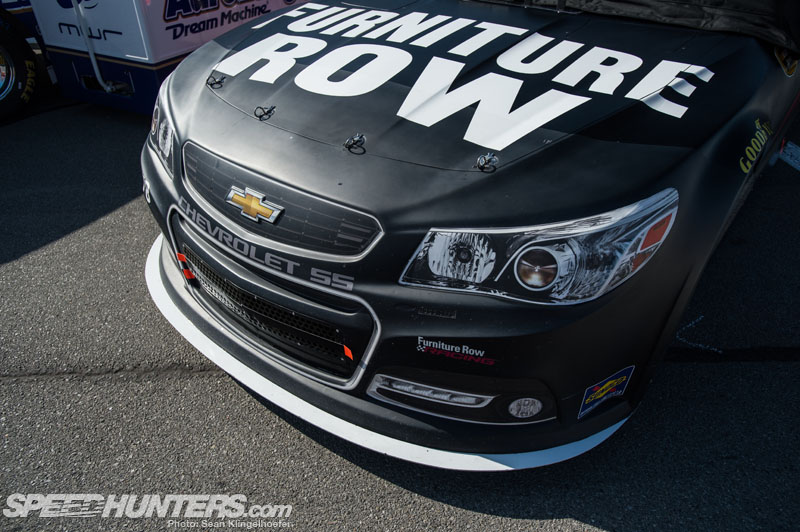
I’m probably one of the only people on earth that will get a kick out of this, but I thought it was worth sharing the different shapes of each brand for a better look. Since the front end is doing most of the work, you’d imagine they’ll all be the same spec with different decals, but they’re actually quite different. The Chevy SS is probably the smoothest and I’d argue the best looking.
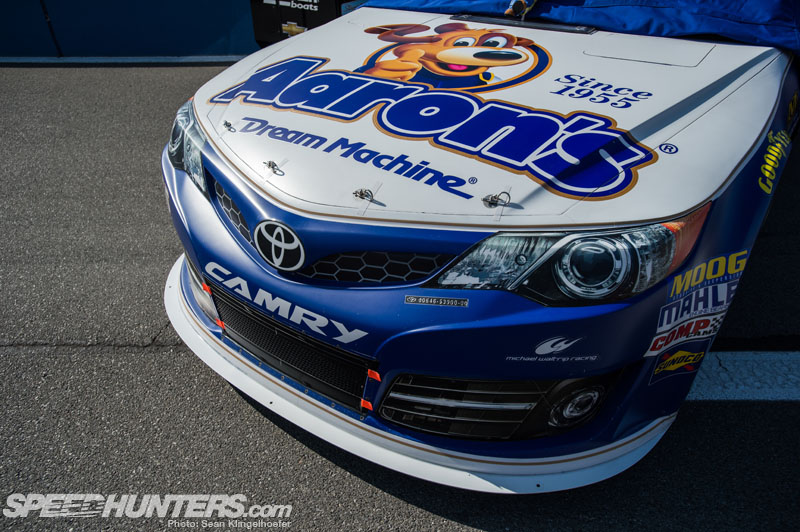
I found the overhang of the grill on the Camry to be shockingly aggressive and I can’t help but wonder what advantages or disadvantages that shape might have. But overall, the Toyota and Chevrolet are quite similar when compared to the Ford…
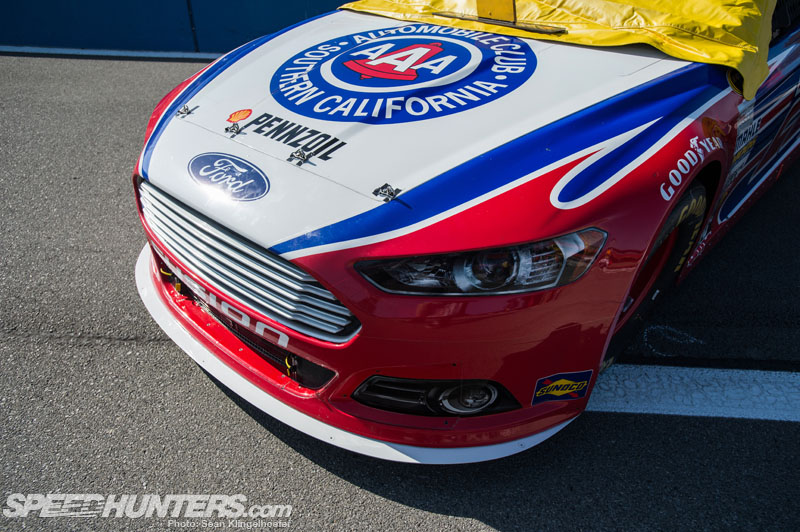
Which has an entirely different shape altogether. The front bumper is dominated by a massive double grill, leaving very little room for body lines or anything else. It’s almost like a massive ventilated air dam, except the upper vents are blocked off.
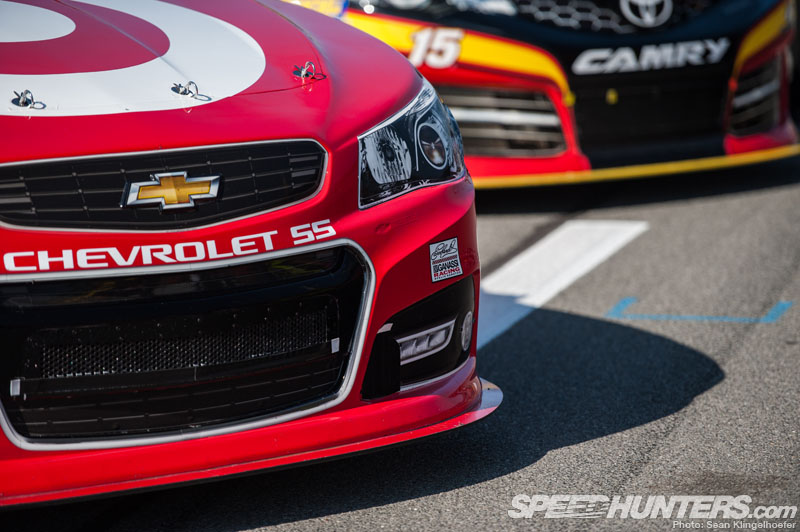
When you get lower down and look at the edge profile of the bumper the cars are actually quite similar… again here’s Chevy…
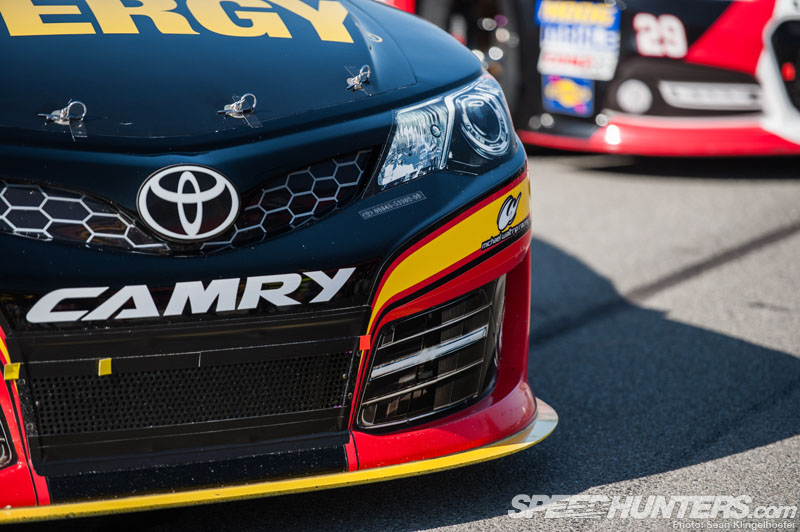
Toyota…
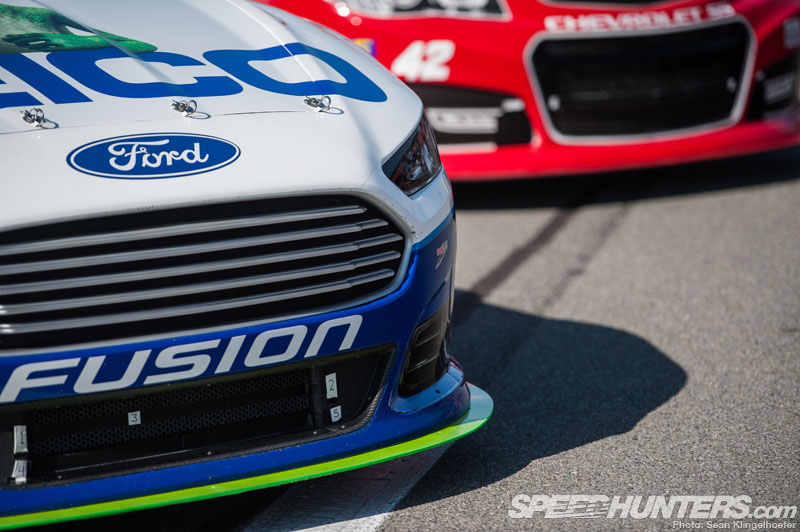
and Ford.
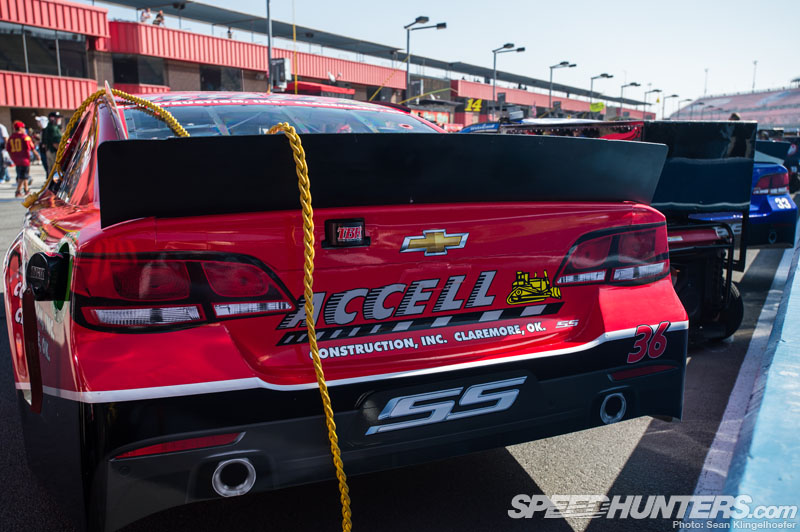
Around back it’s a similar story, but the cars take on more of a spec shape. They actually look a lot like a full scale paper car model, they have that vague shape which is only identifiable by the logo and tail light decals.
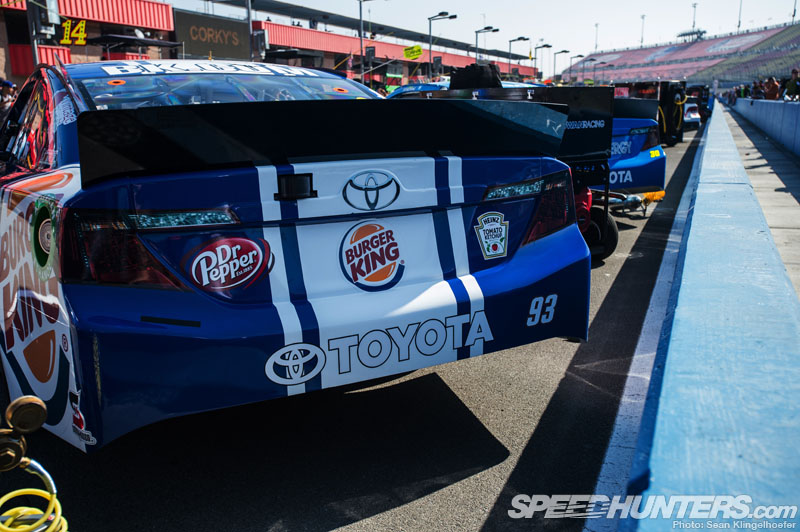
Yep that’s a Camry alright… I think.
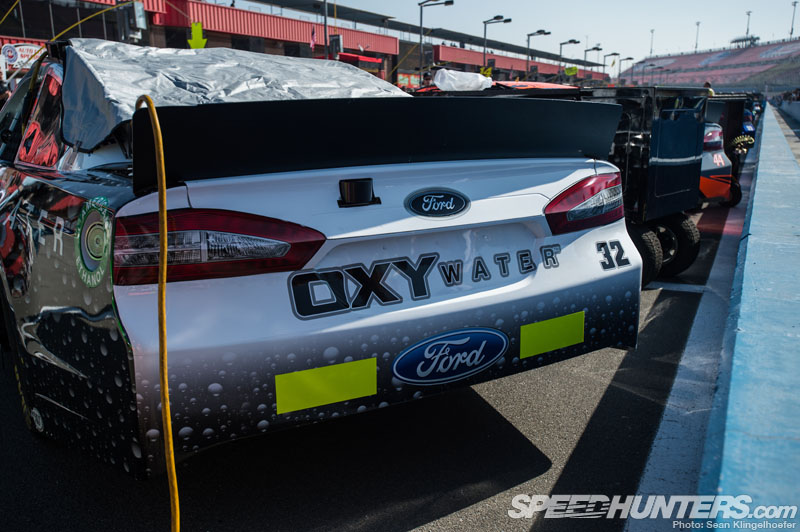
The Fusion rear end actually does have a style line running through the middle of the trunk and into the taillights which carries over from the standard model. Anyway enough dorky stuff, I could have easily gotten caught up looking at the cars right up until the start of the race, but I wanted to get a good position for when the lights went green.
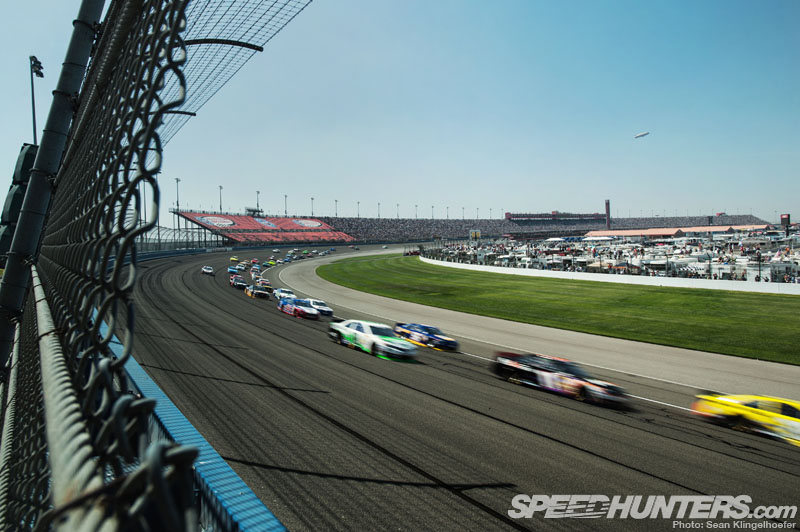
When I got to turn one it was completely filled up by very serious looking photographers who marked their places in tape, so I decided to go elsewhere and find a more unique shot. I ended up in the middle of turn 1 and 2 for the start. Not a bad view.
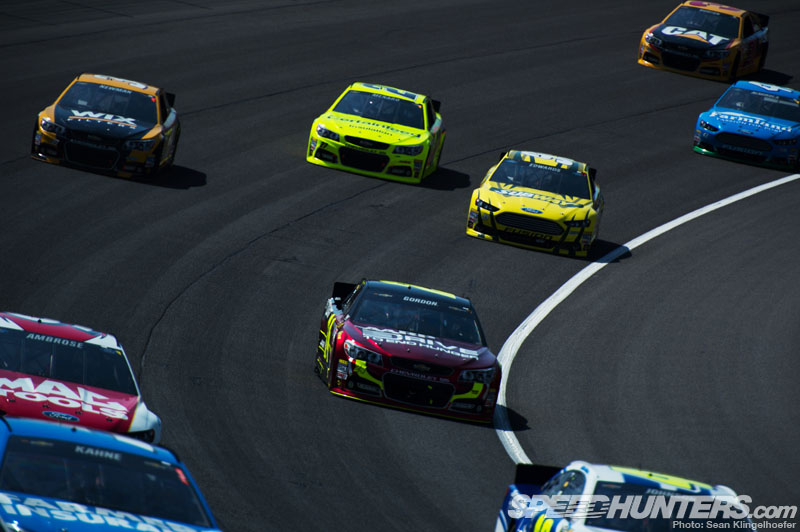
The chaos at the beginning put a grin on my face. Cold tires and loose setups led to some very interesting lines. In fact, I don’t think there was one; the whole track was a virtual no-man’s-land with cars sliding up and down the banking as they pleased. It was amazing.
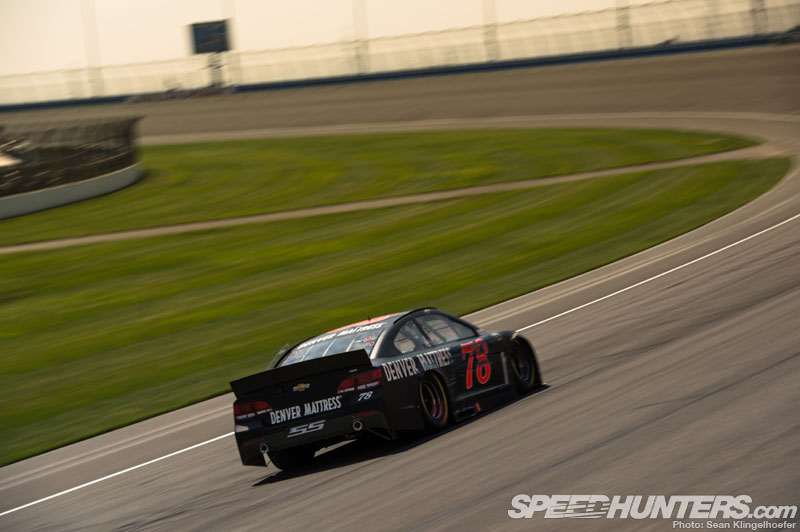
One of the things that hits you right away is just how mind numbingly fast NASCAR actually is. When you watch it on TV you just can’t get the sense of how mental these things are. When a pack of them goes by they bring a gale force wind along with them. And the sound, my god, the sound!
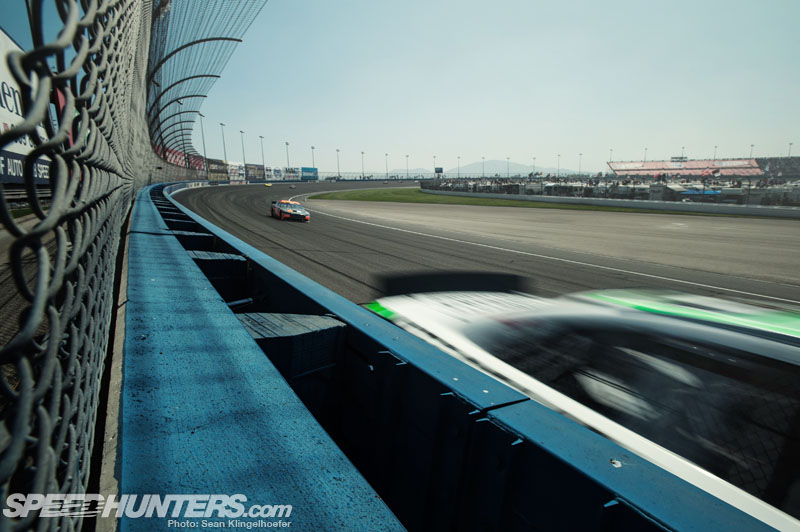
Keeping in mind I’ve shot a variety of motorsport and in that time I’ve seen cars going over 200mph and I’ve been less than one meter (three feet) away from them, but not at the same time! It’s difficult not to flinch when something is moving that fast, that close! Describing the situation as intense is an understatement!
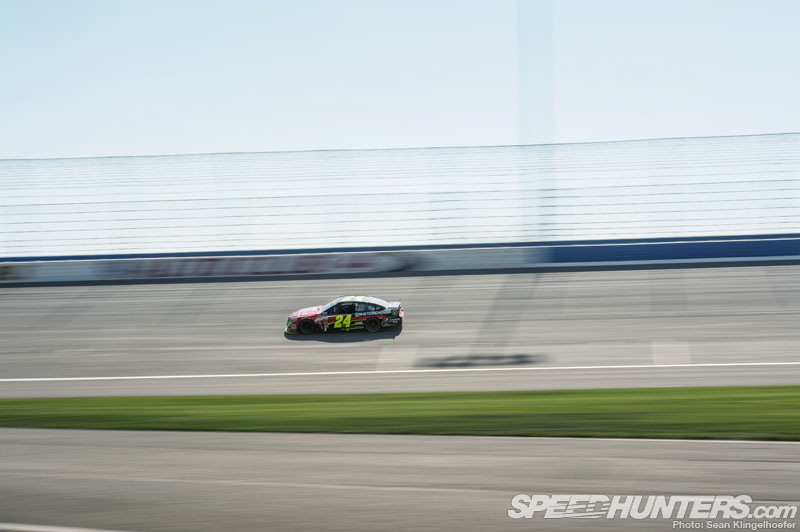
I normally wear noise isolating in-ear headphones when I shoot because they work two-fold as ear plugs and also additional entertainment. Aside from pro-street drag racing, I’ve never been to an event where the cars could overpower the headphones… NASCAR did that no-problem. The roar of the engines is exquisite, something that needs to be heard felt in person.
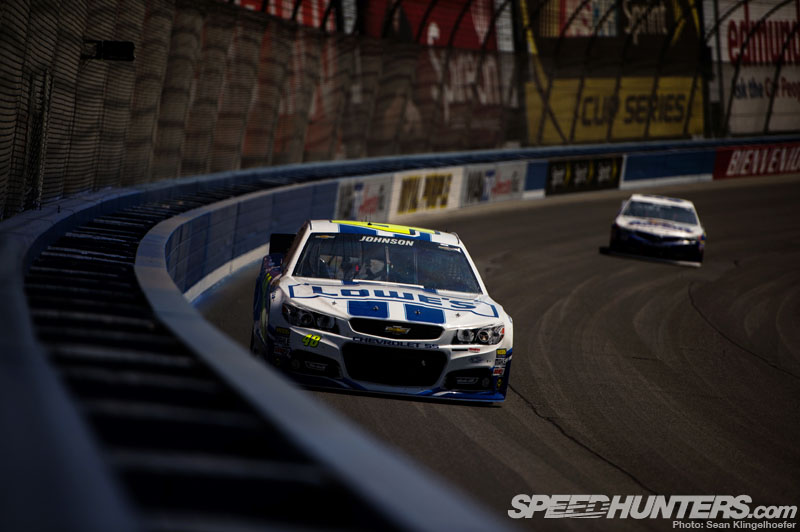
I couldn’t believe how much fun I was having shooting. Before the event I was a little worried thinking about how limited the shooting situations would be, and they were; there were only about six places around the track from which you could shoot. But it didn’t matter, a little bit of imagination goes a long way. Before I knew it the race was already two-thirds of the way through!
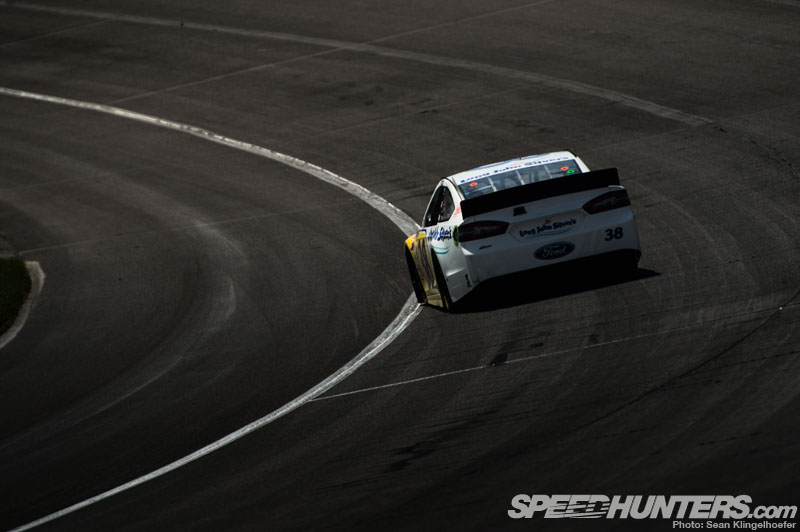
Other than badly misinterpreting the speed, television also does a very poor job at showing just how loose these cars are. I was shocked to see the cars quite literally sliding around the entire corner. I think this shot does a little better justice at describing how sideways the cars actually are. Larry Chen would feel right at home here!
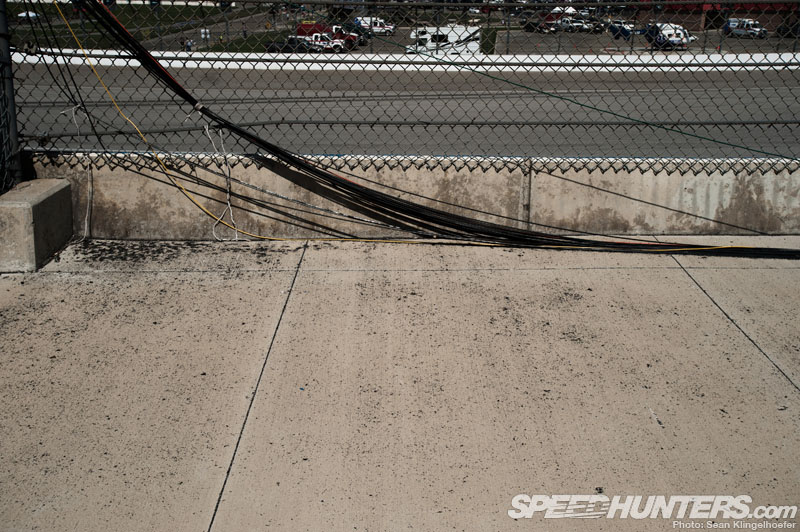
If you need further proof, look no further than the tire dust that can be found lining the entire track. A familiar scene to drifters the world over no doubt.
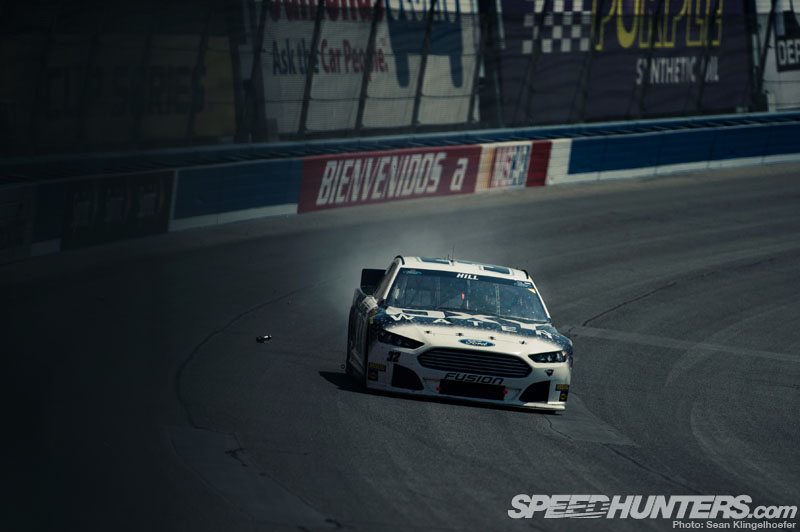
On that Sunday I had the fortune of being in the right place at the right time on several occasions, the first of which was catching this driveline sheering off in turn 2. Less than a second later the large chunk of driveline that can be seen to the left of the car very nearly killed me as it bounced up into the catch fencing at roughly 150mph… it was awesome!
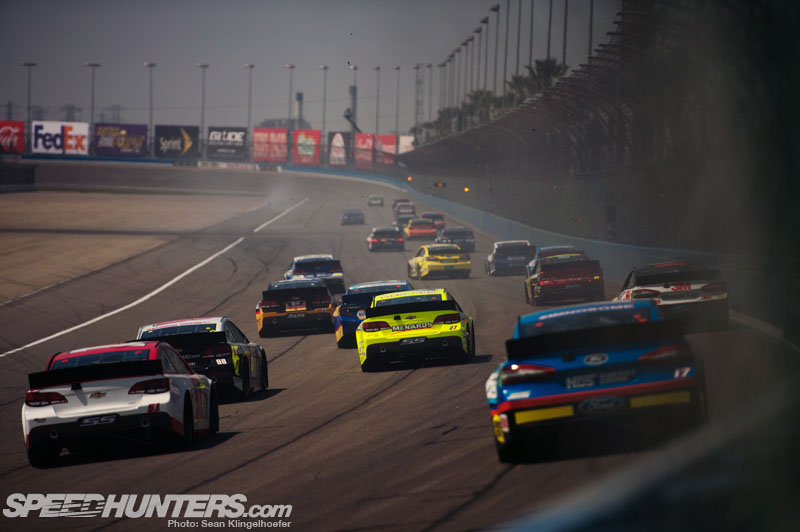
When I turned back around after the close miss, this was the scene heading in the other direction; a pack of cars slowing under yellow with debris scattered in the air all the down the back straight. It was’t one of the catastrophic pile-ups you see on the short tracks, but it was pretty radical nonetheless. Be sure to have a look a the high res desktop.
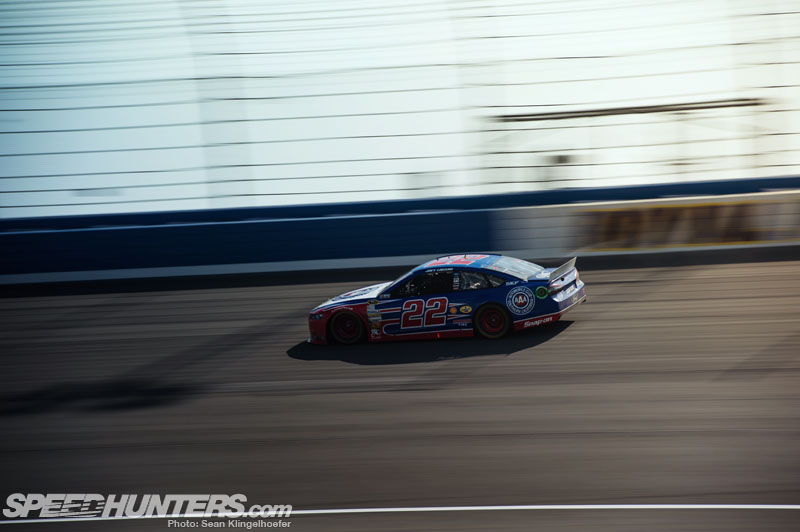
Although I didn’t know it at the time (because I was too immersed in shooting to have any idea what was going on) there was a three-way battle for the lead developing in the closing laps between Joey Logano…
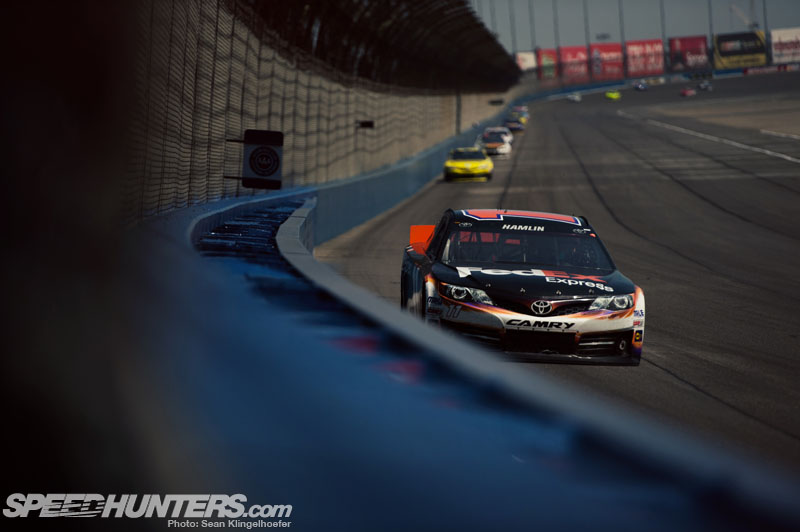
Denny Hamlin…
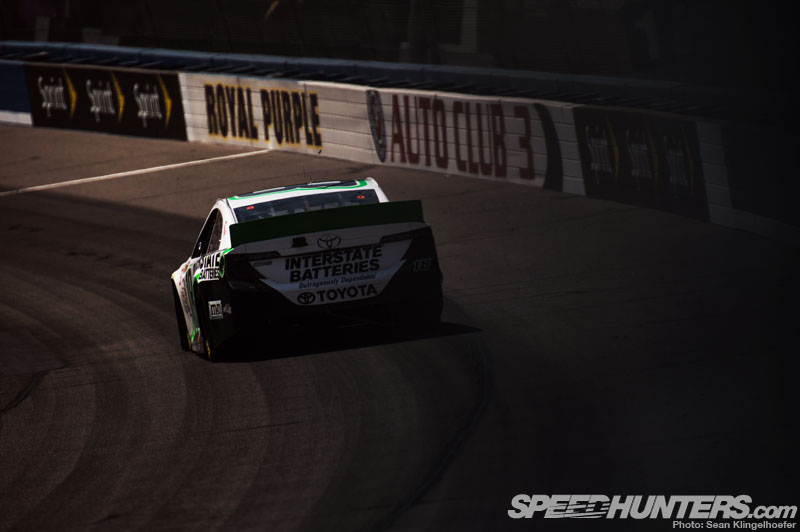
And Kyle Busch who had all been running hard and clean that afternoon.
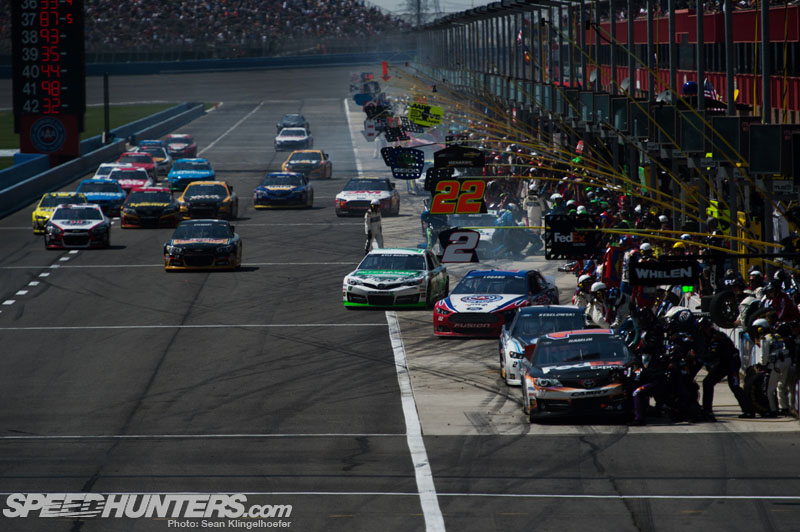
After the final pitstop the running order had been pretty well sorted with Tony Stewart also in tow for a look at a decent finish. After the restart Joey blocked Stewart to keep his front-row position and then fought with Denny for several laps until the two finally collided on the last lap coming out of turn 4, where I was fortunate enough to be standing…
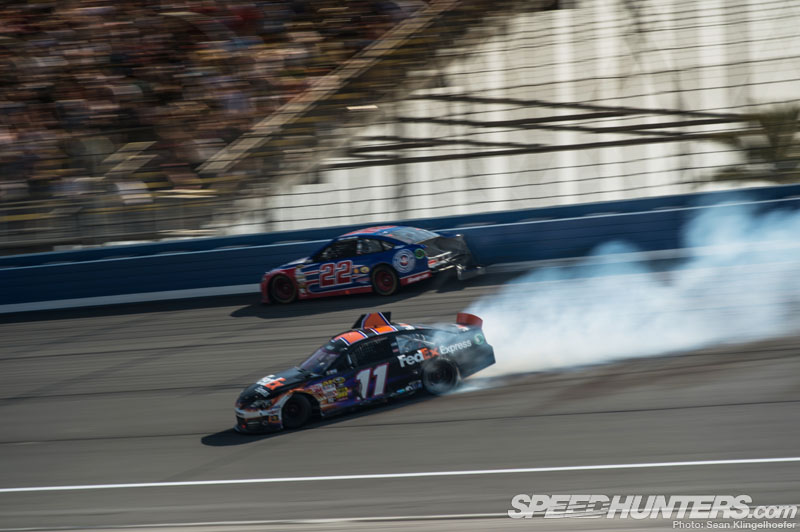
Having no idea that it was the last lap, I was actually changing lenses on one of my cameras when I heard the cars collide, looked up and started firing away with my other body. While I didn’t manage the cleanest shot, I was the only photographer in T4 so at least it’s a unique look! Besides, there’s always video…
Joey managed to scrape along the wall to finish in sixth while Denny was sent to the hospital by helicopter and Kyle secured the win. Hamlin ended up putting his car into an inside wall, a section missing what NASCAR calls “SAFER barrier” which has opened another discussion on safety. It was later confirmed that Hamlin suffered an injury to his L1 vertebrae and won’t be able to drive for at least six weeks. Don’t be fooled, motorsport is still very dangerous.
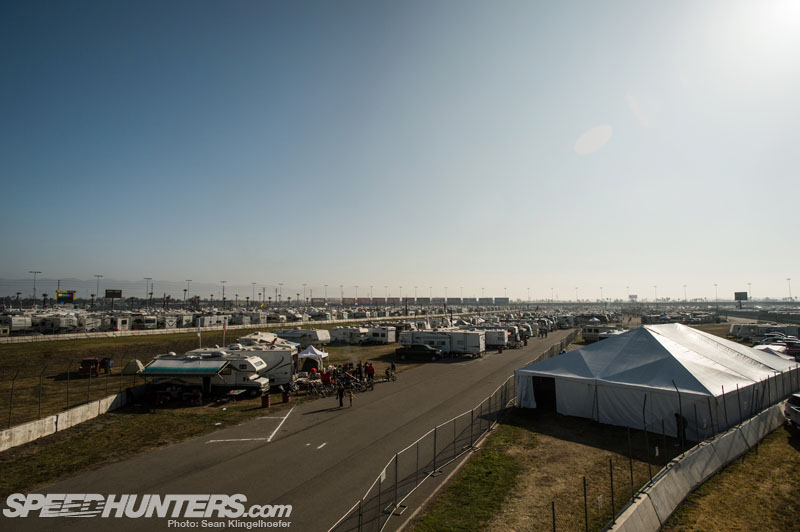
I left Fontana that day with a new found appreciation and respect for NASCAR, I was thoroughly impressed on several fronts. The organization is so professional and polite that it’s almost offensive, and they treat media really well offering free shuttles and a media center with an Internet connection that is actually fast (you’d be amazed how big of an issue this can be). But out of the whole show, I think I was most impressed by the fans.
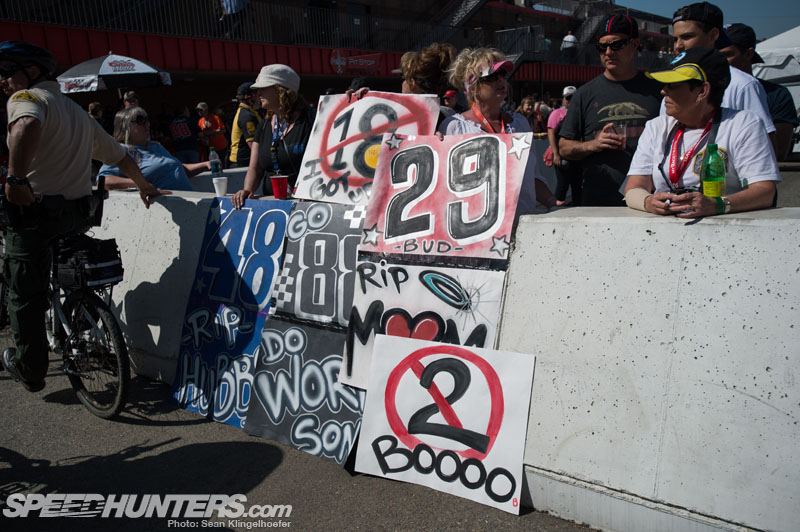
If any other form of motorsport in the US had even half the fan dedication of NASCAR, it would be an incredibly successful series. These people come from far and wide to genuinely cheer on (and boo) their favorite (and least favorite) drivers. It might be the only motorsport where I saw haters and likers in equal amounts, definitely my kind of scene!
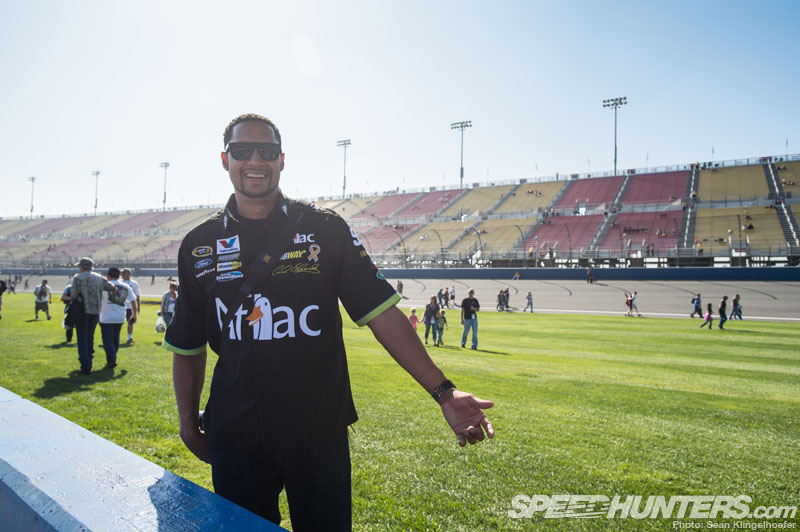
They wear their opinions quite literally on their sleeves and they aren’t afraid to tell you (or yell) about it. They’re very in-tune with what’s going on in the series and quite passionate about following along and becoming a part of the show. It’s an incredible experience and I’m stoked to have finally been a part of it. NASCAR is definitely one event that should be on every petrol head’s bucket list. It’s awesome.
-Sean

photo by Sean Klingelhoefer

photo by Sean Klingelhoefer

photo by Sean Klingelhoefer

photo by Sean Klingelhoefer

photo by Sean Klingelhoefer

photo by Sean Klingelhoefer

photo by Sean Klingelhoefer

photo by Sean Klingelhoefer

photo by Sean Klingelhoefer

photo by Sean Klingelhoefer

photo by Sean Klingelhoefer

photo by Sean Klingelhoefer

photo by Sean Klingelhoefer

photo by Sean Klingelhoefer







